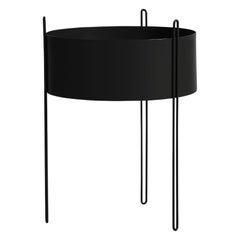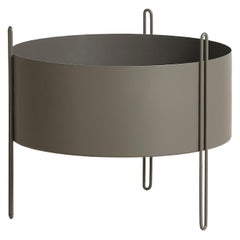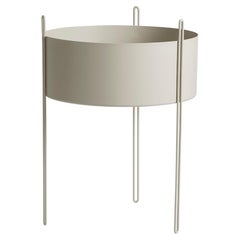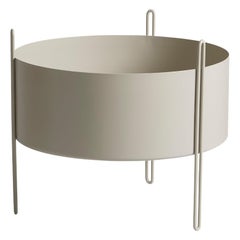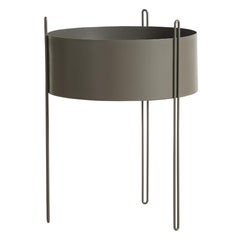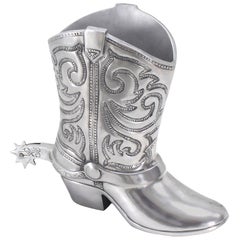Emilie Stahl Carlsen Planter
2010s Danish Post-Modern Planters and Jardinieres
Metal
2010s Danish Post-Modern Planters and Jardinieres
Metal
2010s Danish Post-Modern Planters and Jardinieres
Metal
2010s Danish Post-Modern Planters and Jardinieres
Metal
2010s Danish Post-Modern Planters and Jardinieres
Metal
2010s Danish Post-Modern Planters and Jardinieres
Metal
2010s Danish Post-Modern Planters and Jardinieres
Metal
People Also Browsed
20th Century American Mid-Century Modern Vases
Metal, Aluminum
Vintage 1960s French Mid-Century Modern Planters and Jardinieres
Concrete
Early 20th Century American Arts and Crafts Pedestals
Oak
Vintage 1920s Danish Art Deco Planters, Cachepots and Jardinières
Metal
Antique 19th Century French Planters, Cachepots and Jardinières
Metal, Brass, Tin
21st Century and Contemporary Italian Modern Planters, Cachepots and Jar...
Stainless Steel
Early 20th Century French Neoclassical Planters, Cachepots and Jardinières
Tôle
Early 20th Century French Grand Tour Planters and Jardinieres
Iron
Antique 19th Century Art Nouveau Planters, Cachepots and Jardinières
Brass
20th Century French Planters and Jardinieres
Metal
Antique Late 19th Century English Victorian Planters and Jardinieres
Copper
Late 20th Century American Chinoiserie Planters, Cachepots and Jardinières
Metal
Antique 19th Century Egyptian Revival Pedestals and Columns
Pottery
Vintage 1910s European Edwardian Torchères
Mahogany
Vintage 1970s Italian Mid-Century Modern Planters, Cachepots and Jardini...
Ceramic, Pottery
Antique Late 19th Century Unknown Late Victorian Pedestals
Marble, Brass
A Close Look at post-modern Furniture
Postmodern design was a short-lived movement that manifested itself chiefly in Italy and the United States in the early 1980s. The characteristics of vintage postmodern furniture and other postmodern objects and decor for the home included loud-patterned, usually plastic surfaces; strange proportions, vibrant colors and weird angles; and a vague-at-best relationship between form and function.
ORIGINS OF POSTMODERN FURNITURE DESIGN
- Emerges during the 1960s; popularity explodes during the ’80s
- A reaction to prevailing conventions of modernism by mainly American architects
- Architect Robert Venturi critiques modern architecture in his Complexity and Contradiction in Architecture (1966)
- Theorist Charles Jencks, who championed architecture filled with allusions and cultural references, writes The Language of Post-Modern Architecture (1977)
- Italian design collective the Memphis Group, also known as Memphis Milano, meets for the first time (1980)
- Memphis collective debuts more than 50 objects and furnishings at Salone del Milano (1981)
- Interest in style declines, minimalism gains steam
CHARACTERISTICS OF POSTMODERN FURNITURE DESIGN
- Dizzying graphic patterns and an emphasis on loud, off-the-wall colors
- Use of plastic and laminates, glass, metal and marble; lacquered and painted wood
- Unconventional proportions and abundant ornamentation
- Playful nods to Art Deco and Pop art
POSTMODERN FURNITURE DESIGNERS TO KNOW
- Ettore Sottsass
- Robert Venturi
- Alessandro Mendini
- Michele de Lucchi
- Michael Graves
- Nathalie du Pasquier
VINTAGE POSTMODERN FURNITURE ON 1STDIBS
Critics derided postmodern design as a grandstanding bid for attention and nothing of consequence. Decades later, the fact that postmodernism still has the power to provoke thoughts, along with other reactions, proves they were not entirely correct.
Postmodern design began as an architectural critique. Starting in the 1960s, a small cadre of mainly American architects began to argue that modernism, once high-minded and even noble in its goals, had become stale, stagnant and blandly corporate. Later, in Milan, a cohort of creators led by Ettore Sottsass and Alessandro Mendini — a onetime mentor to Sottsass and a key figure in the Italian Radical movement — brought the discussion to bear on design.
Sottsass, an industrial designer, philosopher and provocateur, gathered a core group of young designers into a collective in 1980 they called Memphis. Members of the Memphis Group, which would come to include Martine Bedin, Michael Graves, Marco Zanini, Shiro Kuramata, Michele de Lucchi and Matteo Thun, saw design as a means of communication, and they wanted it to shout. That it did: The first Memphis collection appeared in 1981 in Milan and broke all the modernist taboos, embracing irony, kitsch, wild ornamentation and bad taste.
Memphis works remain icons of postmodernism: the Sottsass Casablanca bookcase, with its leopard-print plastic veneer; de Lucchi’s First chair, which has been described as having the look of an electronics component; Martine Bedin’s Super lamp: a pull-toy puppy on a power-cord leash. Even though it preceded the Memphis Group’s formal launch, Sottsass’s iconic Ultrafragola mirror — in its conspicuously curved plastic shell with radical pops of pink neon — proves striking in any space and embodies many of the collective’s postmodern ideals.
After the initial Memphis show caused an uproar, the postmodern movement within furniture and interior design quickly took off in America. (Memphis fell out of fashion when the Reagan era gave way to cool 1990’s minimalism.) The architect Robert Venturi had by then already begun a series of plywood chairs for Knoll Inc., with beefy, exaggerated silhouettes of traditional styles such as Queen Anne and Chippendale. In 1982, the new firm Swid Powell enlisted a group of top American architects, including Frank Gehry, Richard Meier, Stanley Tigerman and Venturi to create postmodern tableware in silver, ceramic and glass.
On 1stDibs, the vintage postmodern furniture collection includes chairs, coffee tables, sofas, decorative objects, table lamps and more.
Finding the Right planters-jardinieres for You
Beautiful plants deserve beautiful homes. It’s time to introduce antique and vintage planters and jardinieres to your home’s interiors and outdoor garden area.
The word “jardiniere” has roots in French, but the appeal of these vessels is global. The popularity of jardinieres — ceramic pots intended for cut flowers or plants — quickly gained traction in the United States during the start of the 20th century, when you could find them in some middle- and upper-class American homes. Jardinieres had already been coveted goods overseas for at least a couple of centuries by then, as intricate planters crafted from Chinese porcelain or gilded-bronze versions from Japan could be found in the living rooms of wealthy Europeans.
Today, the love for planters and jardinieres knows no bounds. And whether you consider yourself a proper gardener or merely a doting plant parent, there is likely a use for a planter inside or in the lively outdoor space around your home.
Outside, a pair of marble and terracotta planters or cast-iron urns designed in the neoclassical style can add a stately touch to your landscape design while helping establish boundaries between the areas you’ve created for gardening and entertaining.
Bare corners in your living room or dining room can often be difficult to populate with furnishings that fit just so, and a planter can change that. While it’s possible to get maximal impact from minimalist pottery — an understated mid-century modern planter could deliver on that front — you might be pining for an on-trend planter with pizzazz. Look to an outwardly angular fiberglass design decked out in bright colors to give your blooms a run for their money, while mounted or vintage hanging vessels can serve as the frame for nature’s organic artwork, quite literally taking your gardening skills to the next level.
Browse a broad collection of antique and vintage planters and jardinieres on 1stDibs today.

